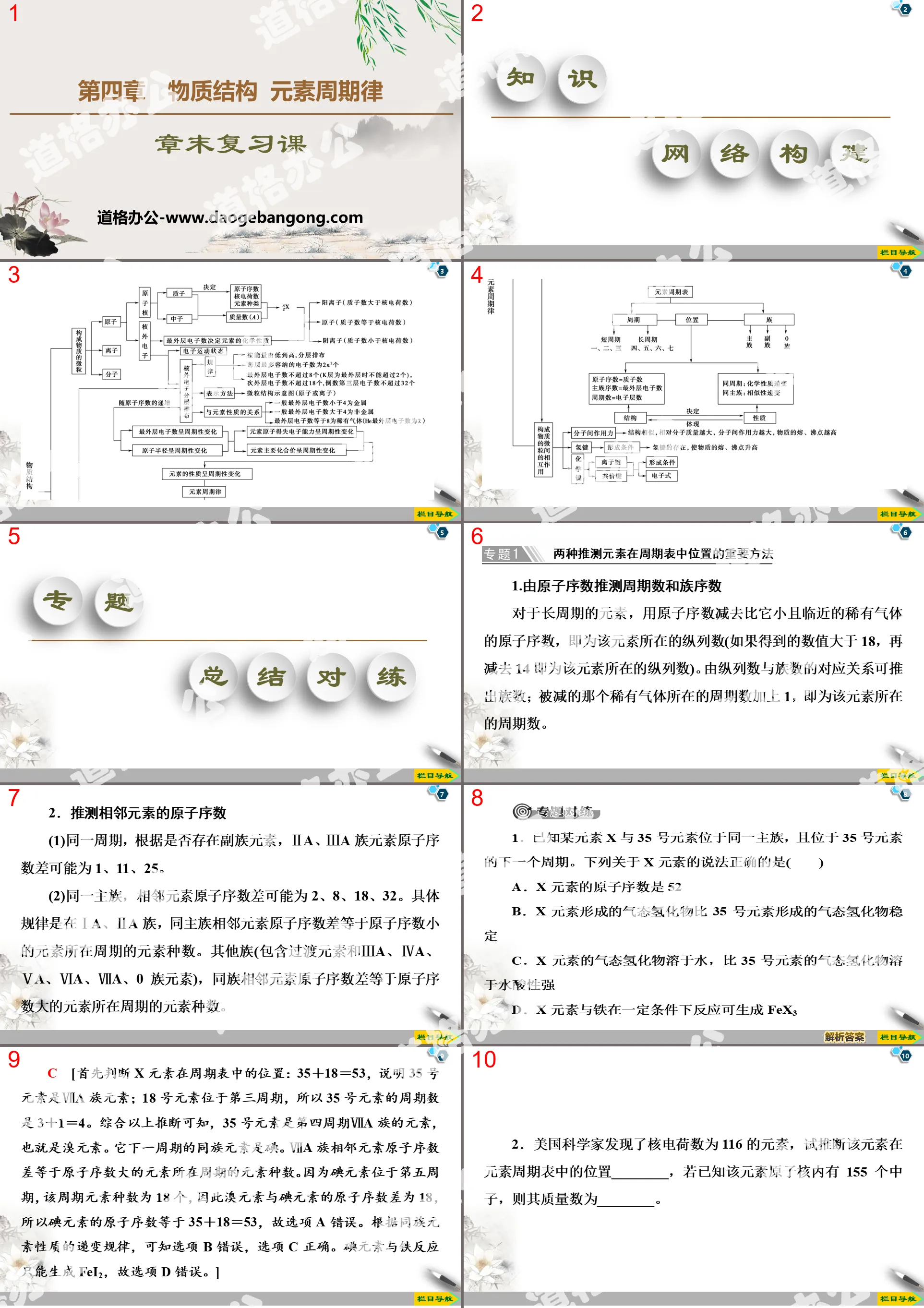People's Education Press High School Chemistry Compulsory Course I
Cantonese Education Edition Ninth Grade Chemistry Volume 1
People's Education Press Ninth Grade Chemistry Volume 1
Beijing Curriculum Reform Edition Ninth Grade Chemistry Volume 1
Beijing Curriculum Reform Edition Ninth Grade Chemistry Volume 2
Lu Jiao Edition Ninth Grade Chemistry Volume 1
Lu Ke Edition High School Chemistry Compulsory Course 1
Cantonese Education Edition Ninth Grade Chemistry Volume 2
Hunan Education Edition Ninth Grade Chemistry Volume 1
People's Education Press Ninth Grade Chemistry Volume 2
People's Education Press High School Chemistry Compulsory Course 2
Lu Ke Edition High School Chemistry Compulsory Course 2
Hunan Education Edition Ninth Grade Chemistry Volume 2
Lu Jiao Edition Ninth Grade Chemistry Volume 2

| Category | Format | Size |
|---|---|---|
| People's Education Press High School Chemistry Compulsory Course I | pptx | 6 MB |
Description
"End of Chapter Review Lesson" Periodic Law of Elements of Material Structure PPT
Special topic summary and practice
Two important methods for inferring the position of elements in the periodic table
1. Infer the period number and group number from the atomic number
For long-period elements, subtract the atomic number of the smaller and adjacent rare gas from the atomic number to determine the column number of the element (if the obtained value is greater than 18, subtract 14 to determine the column number of the element). number of columns). The group number can be deduced from the correspondence between the column number and the group number; the period number of the subtracted rare gas plus 1 is the period number of the element.
2. Infer the atomic numbers of adjacent elements
(1) In the same period, depending on whether there are subgroup elements, the difference in atomic number of group IIA and IIIA elements may be 1, 11, or 25.
(2) The difference in atomic numbers of adjacent elements in the same main group may be 2, 8, 18, or 32. The specific rule is that in groups IA and IIA, the difference in atomic numbers of adjacent elements in the same main group is equal to the number of element species in the period of the element with the smaller atomic number. In other groups (including transition elements and group IIIA, IVA, VA, VIA, VIIA, and 0 elements), the difference in atomic number of adjacent elements in the same group is equal to the number of elements in the period of the element with the larger atomic number.
Thematic sparring
1. It is known that a certain element X is in the same main group as element 35, and is located in the next cycle of element 35. Which of the following statements about element X is correct ()
A. The atomic number of element X is 52
B. The gaseous hydride formed by element X is more stable than the gaseous hydride formed by element 35
C. The gaseous hydride of element
D. X element reacts with iron under certain conditions to generate FeX3
C: First determine the position of element Based on the above inference, it can be seen that element 35 is an element of Group VIIA of the fourth period, which is bromine. Its next cycle cognate is iodine. The difference in atomic numbers of adjacent elements in Group VIIA is equal to the number of elements in the period of the element with the larger atomic number. Because the iodine element is in the fifth period, and the number of elements in this period is 18, the atomic number difference between the bromine element and the iodine element is 18, so the atomic number of the iodine element is equal to 35 + 18 = 53, so option A is incorrect. According to the gradient law of properties of elements of the same family, it can be seen that option B is wrong and option C is correct. The reaction between iodine and iron can only produce FeI2, so option D is incorrect. ]
2. American scientists have discovered an element with a nuclear charge of 116. Try to deduce the element's position in the periodic table ________. If it is known that there are 155 neutrons in the nucleus of the element, its mass number is ________.
Illustration of the relationship between chemical bond types and substance classes
1. Relationship diagram between chemical bond types and substance categories
2. Judgment rules for the relationship between chemical bond types and substance categories
(1) Substances containing ionic bonds must be ionic compounds, because ionic compounds are composed of ions formed from different elements.
(2) When the elemental elements of metal elements in Groups IA and IIA react with the elemental elements of non-metallic elements in Groups VIA and VIIA, they generally combine through ionic bonds to form ionic compounds.
(3) Ionic compounds are formed through ionic bonds between metal cations and certain atomic groups (such as NO-3, CO2-3, SO2-4, OH-, etc.).
(4) Ionic bonds may be formed between various non-metal elements, the most common ones being ammonium salts, such as NH4Cl, (NH4)2S, etc.
(5) Ionic compounds may contain covalent bonds (polar or non-polar covalent bonds), such as NaOH, Na2O2, etc.
(6) Substances containing only polar covalent bonds must be covalent compounds, such as HCl, H2SO4, H2O, etc.
(7) Substances containing only non-polar covalent bonds must be non-metallic elements, such as N2, H2, Cl2, etc.
(8) Covalent compounds must not contain ionic bonds, but may contain non-polar covalent bonds, such as etc.
Thematic sparring
3. Which of the following statements about chemical bonds is correct ()
A. Both the sublimation of iodine crystals and the melting of ice involve changes in chemical bonds
B. Chemical bonds are broken when sodium chloride melts or when hydrogen chloride dissolves in water
C. Ionic compounds may contain covalent bonds Covalent compounds may contain ionic bonds
D. Ammonium chloride turns into a gas when heated and then crystallizes when cooled. The chemical bonds do not change during this process.
4. Which of the following statements is incorrect ()
A. Non-metallic elemental chlorine, white phosphorus, ozone, etc. all contain non-polar bonds
B. The compounds hydrogen peroxide, sulfuric acid, and methane all contain polar bonds.
C. Carbon dioxide, sulfur trioxide, and sodium peroxide all contain covalent bonds
D. Ionic compounds must not contain covalent bonds
D [Non-metallic elements (except rare gases) all contain non-polar bonds, so statement A is correct; the structural formula of H2O2 is H—O—O—H, and hydrogen peroxide, sulfuric acid, and methane all contain polar covalent bonds. Valence bonds, so statement B is correct; CO2 and SO3 are covalent compounds, Na2O2 contains O2-2, and O2-2 contains non-polar covalent bonds, so statement C is correct; ionic compounds may contain covalent bonds, such as NaOH and Na2O2, etc., so statement D is wrong. ]
Keywords: Free download of the PPT courseware for High School Chemistry Compulsory Course 1 from the People's Education Press, PPT download of the end-of-chapter review lesson, PPT download of the periodic law of elements in the structure of matter, .PPT format;
For more information about the "Periodic Law of Elements End-of-Chapter Review Lesson Structure of Matter" PPT courseware, please click the "Periodic Law of Elements PPT End-of-Chapter Review Lesson PPT Structure of Matter PPT" tag.
"End of Chapter Review Lesson" Newton's Laws of Motion PPT:
"End-of-Chapter Review Course" Newton's Laws of Motion PPT Part One Content: Consolidation Level Knowledge Integration [Core Quick Filling] 1. The relationship between force and motion: Force can _____ the motion state of an object. 2. Newton's first law: All objects remain at rest or __________..
"End of Chapter Review Lesson" Force and Balance PPT:
"End of Chapter Review Course" Strength and Balance PPT Part One Content: Consolidation Level Knowledge Integration [Core Quick Filling] 1. Synthesis and decomposition of force (1) Obey the rules: _________ rule or _________ rule. (2) The range of the resultant force of two common point forces: _________F_______..
"End of Chapter Review Lesson" interactive PPT:
"End-of-Chapter Review Lesson" Interactive PPT Part One: Consolidation Level Knowledge Integration [Core Quick Filling] 1. The concept of force (1)Vectorality: both ____ and ____. (2) Effect: Make the object ____, change the ____ of the object. 2. Gravity (1)Definition..
File Info
Update Time: 2024-10-01
This template belongs to Chemistry courseware People's Education Press High School Chemistry Compulsory Course I industry PPT template
"End of Chapter Review Lesson" Periodic Law of Elements of Material Structure PPT Simple campus recruitment activity planning plan summary enterprise and institution recruitment publicity lecture PPT template is a general PPT template for business post competition provided by the manuscript PPT, simple campus recruitment activity planning plan summary enterprise and institution recruitment promotion Lecture PPT template, you can edit and modify the text and pictures in the source file by downloading the source file. If you want more exquisite business PPT templates, you can come to grid resource. Doug resource PPT, massive PPT template slide material download, we only make high-quality PPT templates!
Tips: If you open the template and feel that it is not suitable for all your needs, you can search for related content "End of Chapter Review Lesson" Periodic Law of Elements of Material Structure PPT is enough.
How to use the Windows system template
Directly decompress the file and use it with office or wps
How to use the Mac system template
Directly decompress the file and use it Office or wps can be used
Related reading
For more detailed PPT-related tutorials and font tutorials, you can view: Click to see
How to create a high-quality technological sense PPT? 4 ways to share the bottom of the box
Notice
Do not download in WeChat, Zhihu, QQ, built-in browsers, please use mobile browsers to download! If you are a mobile phone user, please download it on your computer!
1. The manuscript PPT is only for study and reference, please delete it 24 hours after downloading.
2. If the resource involves your legitimate rights and interests, delete it immediately.
3. Contact information: service@daogebangong.com
"End of Chapter Review Lesson" Periodic Law of Elements of Material Structure PPT, due to usage restrictions, it is only for personal study and reference use. For commercial use, please go to the relevant official website for authorization.
(Personal non-commercial use refers to the use of this font to complete the display of personal works, including but not limited to the design of personal papers, resumes, etc.)
Preview










